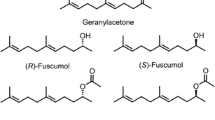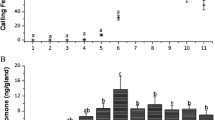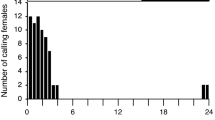Abstract
The aggregation pheromone ofGnathotrichus retusus was isolated and identified as (S)-(+)-sulcatol (6-methyl-5-hepten-2-ol). In laboratory and field experiments,G. retusus responded to (S)-(+)-sulcatol, but not to (±)-sulcatol, which was attractive to the sympatric species,G. sulcatus. G. sulcatus did not respond to optically pure (S)-(+)-sulcatol, but began to respond when ⩾ 1% (R)-(−)-sulcatol was present in an enantiomeric mixture.
Similar content being viewed by others
References
Birch, M.C., Light, D.M., andMori, K. 1977. Selective inhibition of response ofIps pini to its pheromone by the (S)-(−)-enantiomer of ipsenol.Nature 270:738–739.
Blum, M.S. 1977. Insect pheromones, pp. 209–236,in J.R. Plimmer (ed.). Pesticide Chemistry in the 20th Century. American Chemical Society, Washington, D.C.
Borden, J.H., andMcLean, J.A. 1979. Secondary attraction inGnathotrichus retusus and cross-attraction inG. sulcatus (Coleoptera: Scolytidae).J. Chem. Ecol 5:79–88.
Borden, J.H., andStokkink, E. 1973. Laboratory investigation of secondary attraction inGnathotrichus sulcatus (Coleoptera: Scolytidae).Can. J. Zool. 51:469–473.
Borden, J.H., Chong, L., Mclean, J.A., Slessor, K.N., andMori, K. 1976.Gnathotrichus sulcatus: Synergistic response to enantiomers of the aggregation pheromone sulcatol.Science 192:894–896.
Borden, J.H., Handley, J.R., Johnston, B.D., MacConnell, J.G., Silverstein, R.M., Slessor, K.N., Swigar, A.A., andWong, D.T.W. 1979. Synthesis and field testing of lineatin, the aggregation pheromone ofTrypodendron lineatum (Coleoptera: Scolytidae).J. Chem. Ecol. 5:681–689.
Brownlee, R.G., andSilverstein, R.M. 1968. A micro-preparative gas chromatograph and modified carbon skeleton determinator.Anal. Chem. 40:2077–2079.
Byrne, K.J., Siwgar, A.A., Silverstein, R.M., Borden, J.H., andStokkink, E. 1974. Sulcatol: population aggregation pheromone in the scolytid beetle,Gnathotrichus sulcatus.J. Insect Physiol. 20:1895–1900.
Byrne, K.J., Gore, W.E., Pearce, G.T., andSilverstein, R.M. 1975. Porapak-Q collection of airborne organic compounds serving as models for insect pheromones.,J. Chem, Ecol. 1:1–7.
Iwaki, S., Marmo, S., Saito, T., Yamida, M., andKatagiri, K. 1974. Synthesis and activity of optically active disparlure.J. Am. Chem. Soc. 96:7842–7844.
Johnston, B.D., andSlessor, K.N. 1979. Facile synthesis of the enantiomers of sulcatol.Can. J. Chem. 57:233–235.
Lanier, G.N., andBurkholder, W.E. 1974. Pheromones in speciation of Coleoptera, pp. 161–189,in M.C. Birch (ed.). Pheromones. North Holland, Amsterdam.
Lanier, G.N., andWood, D.L. 1975. Specificity of response to pheromones in the genusIps (Coleoptera: Scolytidae).J. Chem. Ecol. 1:9–23.
MacConnell, J.G., Borden, J.H., Silverstein, R.M., andStokkink, E. 1977. Isolation and tentative identification of lineatin, a pheromone from the frass ofTrypodendron lineatum (Coleoptera: Scolytidae).J. Chem. Ecol. 3:549–561.
McLean, J.A., andBorden, J.H. 1977. Suppression ofGnathotrichus sulcatus with sulcatol baited traps in a commerical sawmill and notes on the occurrence ofG. retusus andTrypodendron lineatum.Can. J. For. Res. 7:348–356.
McLean, J.A., andBorden, J.H. 1979. An operational pheromone-based suppression program for an ambrosia beetle,Gnathotrichus sulcatus, in a commercial sawmill.J. Econ. Entomol. 72:165–172.
Miller, J.R., Mori, K., andRoelofs, W.L. 1977. Gypsy moth field trapping and electroantennogram studies with pheromone enatiomers.J. Insect Physiol. 23:1447–1453.
Plummer, E.L., Stewart, T.E., Byrne, K., Pearce, G.T., andSilverstein, R.M. 1976. Determination of the enantiomeric composition of several insect pheromone alcohols.J. Chem. Ecol. 2:307–331.
Riley, R.G., Silverstein, R. M., andMoser, J.C. 1974. Biological responses ofAtta texana to its alarm pheromone and the enantiomer of the pheromone.Science 183:760–762.
Schuler, H.R., andSlessor, K.N. 1977. Synthesis of enantiomers of sulcatol.Can. J. Chem. 55:3280–3287.
Silverstein, R.M. 1971. Recent and current collaborative studies of insect pheromones, pp. 69–89,in A.S. Tahori (ed.). Chemical Releasers in Insects. Gordon and Breach, New York.
Silverstein, R.M. 1977. Complexity, diversity, and specificity of behavior-modifying chemicals: Examples mainly from Coleoptera and Hymenoptera, pp. 231–251,in H.H. Shorey and J.J. McKelvey (eds.). Chemical Control of Insect Behavior: Theory and Application. John Wiley & Sons, New York.
Silverstein, R.M. 1979. Enantiomeric composition and bioactivity of chiral semiochemicals in insects, pp. 133–146,in F.J. Ritter (ed.). Chemical Ecology: Odour Communication in Animals. Elsevier-North Holland, Amsterdam.
Silverstein, R.M., andYoung, J.C. 1976. Insects generally use multicomponent pheromones, pp. 1–29,in M. Beroza (ed.). Pest Management with Insect Sex Attractants and Other Behavior-Controlling Chemicals. American Chemical Society, Washington, D.C.
Stewart, T.E., Plummer, E.L., McCandless, L.L., West, J.R., andSilverstein, R.M. 1977. Determination of the enantiomeric composition of several bicyclic ketal insect pheromone components.J. Chem. Ecol. 3:27–43.
Tumlinson, J.H., Klein, M.G., Doolittle, R.E., Ladd, T.L., andProveaux, A.T. 1977. Identification of the female Japanese beetle sex pheromone: Inhibition of male response by an enantiomer.Science 197:789–792.
Vité, J.P., Klimetzek, D., Loskant, G., Hedden, R., andMori, K. 1976. Chirality of insect pheromones: response interruption by active antipodes.Naturwissenschaften 63:582–583.
Vité, J.P., Ohloff, G., andBillings, R.F. 1978. Pheromonal chirality, and integrity of aggregation response in southern species of the bark beetlesIps sp.Nature 272:817–818.
Wood, D.L., andBushing, R.W. 1963. The olfactory response ofIps confusus (LeConte) (Coleoptera: Scolytidae) to the secondary attraction in the laboratory.Can. Entomol. 95:1066–1078.
Wood, D.L., Browne, L.E., Ewing, B., Lindahl, K., Bedard, W.D., Tilden, P.E., Mori, K., Pitman, G.B., andHughes, P.R. 1976. Western pine beetle: specificity among enantiomers of male and female components of an attractant pheromone.Science 192:896–898.
Author information
Authors and Affiliations
Additional information
Research supported by the National Science Foundation, U.S.A. (Grant BMS-74-13643), and the Natural Sciences and Engineering Research Council of Canada (Co-op grant A0243 and Operating Grant A3881 and A3785).
Rights and permissions
About this article
Cite this article
Bordon, J.H., Handley, J.R., McLean, J.A. et al. Enantiomer-based specificity in pheromone communication by two sympatricGnathoirichus species (Coleoptera: Scolytidae). J Chem Ecol 6, 445–456 (1980). https://doi.org/10.1007/BF01402921
Received:
Revised:
Issue Date:
DOI: https://doi.org/10.1007/BF01402921




